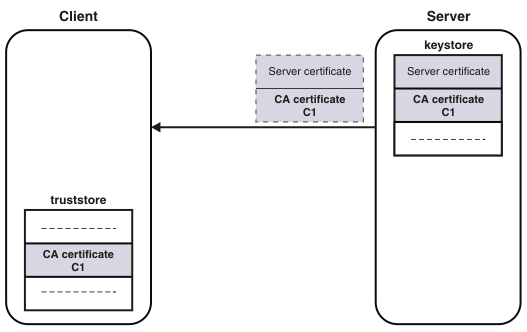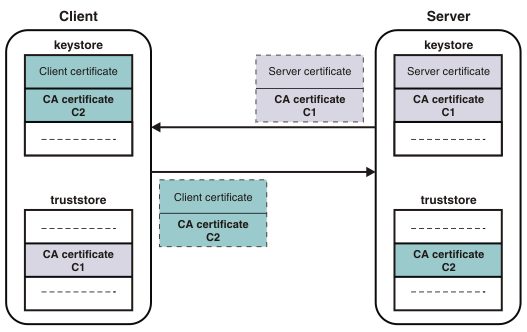- Establishes the identity of the owner of the certificate
- Distributes the owner's public key
Certificates are issued by trusted third parties, called certificate authorities (CAs). These authorities can be commercial ventures or local entities, depending on the requirements of your application. The CA is trusted to adequately authenticate users before issuing certificates. A CA issues certificates with digital signatures. When a user presents a certificate, the recipient of the certificate validates it by using the digital signature. If the digital signature validates the certificate, the certificate is recognized as intact and authentic. Participants in an application need to validate certificates only; they do not need to authenticate users. The fact that a user can present a valid certificate proves that the CA has authenticated the user. The designation, "trusted third parties", indicates that the system relies on the trustworthiness of the CAs.
- A keystore holds the private keys and public key certificates for an application.
- A truststore contains the CA certificates required to authenticate certificates that are presented by another application.
Contents of a digital certificate
- The distinguished name (DN) of the owner. A DN is a unique identifier, a fully qualified name including not only the common name (CN) of the owner but also the owner's organization and other distinguishing information.
- The public key of the owner.
- The date on which the certificate is issued.
- The date on which the certificate expires.
- The distinguished name of the issuing CA.
- The digital signature of the issuing CA. The message-digest function creates a signature based upon all the previously listed fields.
The idea of a certificate is that a CA takes the public key of the owner, signs the public key with its own private key, and returns the information to the owner as a certificate. When the owner distributes the certificate to another party, it signs the certificate with its private key. The receiver can extract the certificate that contains the CA signature with the public key of the owner. By using the CA public key and the CA signature on the extracted certificate, the receiver can validate the CA signature. If valid, the public key that is used to extract the certificate is considered good. The owner signature is validated, and if the validation succeeds, the owner is successfully authenticated to the receiver.
The additional information in a certificate helps an application to determine whether to honor the certificate. With the expiration date, the application can determine if the certificate is still valid. With the name of the issuing CA, the application can check that the CA is considered trustworthy by the site.
An application that needs to authenticate itself must provide its personal certificate, the one containing its public key, and the certificate of the CA that signed its certificate, called a signer certificate. In cases where chains of trust are established, several signer certificates can be involved.
Requesting certificates
- The distinguished name of the owner or the user for whom the certificate is requested
- The public key of the owner
- The digital signature of the owner
The message digest function creates a signature based on all the previously listed fields.
The CA verifies the signature with the public key in the request to ensure that the request is intact and authentic. The CA then authenticates the owner. Exactly what the authentication consists of depends on a prior agreement between the CA and the requesting organization. If the owner in the request is authenticated successfully, the CA issues a certificate for that owner.
Using certificates: Chain of trust and self-signed certificate
To verify the digital signature on a certificate, you must have the public key of the issuing CA. Public keys are distributed in certificates, therefore you must have a certificate for the issuing CA that is signed by the issuer. One CA can certify other CAs, so a chain of CAs can issue certificates for other CAs, all of whose public keys you need. Eventually, you reach a root CA that issues itself a self-signed certificate. To validate a user certificate, you need certificates for all of the intervening participants back to the root CA. You then have the public keys that you need to validate each certificate, including the user certificate.
A self-signed certificate contains the public key of the issuer and is signed with the private key. The digital signature is validated like any other, and if the certificate is valid, the public key it contains is used to check the validity of other certificates issued by the CA. However, anyone can generate a self-signed certificate. In fact, you can probably generate self-signed certificates for testing purposes before installing production certificates. The fact that a self-signed certificate contains a valid public key does not mean that the issuer is a trusted certificate authority. To ensure that self-signed certificates are generated by trusted CAs, such certificates must be distributed by secure means; for example, hand-delivered on floppy disks, downloaded from secure sites, and so on.
Applications that use certificates store these certificates in a keystore file. This file typically contains the necessary personal certificates, its signing certificates, and its private key. The private key is used by the application to create digital signatures. Servers always have personal certificates in their keystore files. A client requires a personal certificate only if the client must authenticate to the server when mutual authentication is enabled.
To allow a client to authenticate a server, a server keystore file contains the private key and the certificate of the server and the certificates of its CA. A client truststore file must contain the signer certificates of the CAs of each server, which the client must authenticate. The following diagram illustrates how a client authenticates a server.

If mutual authentication is needed, the client keystore file must contain the client private key and certificate. The server truststore file requires a copy of the certificate of the client CA. The following diagram illustrates mutual authentication.

 Last updated Friday, 21 July 2017
Last updated Friday, 21 July 2017